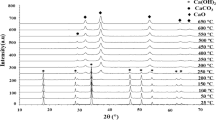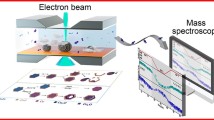Summary.
Coordination compounds Zn(mal)(H2O)2 (ZMH) (mal=maleate anion (C2H2(CO2)22-)), Cu0.06Zn0.94(mal)(H2O)2 (ZCMH), Cu(mal)(H2O) (CMH), and physical mixtures of CMH and ZMH were used as precursors for calcination experiments in air at 500 and 1000°C lasting 18 hours. The obtained oxides were investigated by X-ray powder diffraction technique. Calcination at 500°C yielded pure zincite phase (ZnO), tenorite phase (CuO), or their mixtures. The calcination of the Zn-rich sample ZCMH at 1000°C lead to zincite phase displaying a slightly lower cell volume than the pure zincite phase obtained from Zn-only containing precursor (ZMH). These results suggest that the assumed solid solution Cu x Zn 1−x O (x=0.01−0.02) exhibits a solubility limit lower than the copper content in the ZCMH precursor (6 mol-%). On the other hand, the calcination of the Cu-rich samples at 1000°C, in the presence of Zn(II), yielded tenorite phase exhibiting cell parameters significantly different from those reported for the pure tenorite phase, due to the formation of Zn0.03Cu0.97O solid solutions. All these results are corroborated by intensity analysis of the diffraction peaks.
Similar content being viewed by others
Author information
Authors and Affiliations
Corresponding author
Rights and permissions
About this article
Cite this article
Černák, J., Gérard, F., Kappenstein, C. et al. Copper/Zinc Oxide Catalysts. Part XII. Solid Solution Formation in the CuO/ZnO System. X-Ray Powder Diffraction Study. Monatshefte für Chemie 135, 1081–1088 (2004). https://doi.org/10.1007/s00706-004-0205-7
Received:
Accepted:
Published:
Issue Date:
DOI: https://doi.org/10.1007/s00706-004-0205-7




